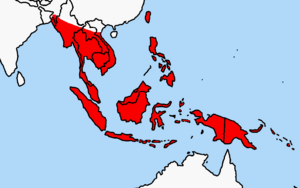Polynesian rat facts for kids
Quick facts for kids Polynesian rat |
|
|---|---|
 |
|
| Conservation status | |
| Scientific classification | |
| Genus: |
Rattus
|
| Species: |
exulans
|
 |
|
| Polynesian rat native range in Southeast Asia (in red) (note: the IUCN Red List instead considers it introduced throughout all of its Pacific islands range, as well as Brunei, Singapore, and the Philippines) | |
The Polynesian rat is also called the Pacific rat or little rat. Its scientific name is Rattus exulans. The Māori people call it kiore. It is the third most common type of rat in the world. Only the brown rat and black rat are found in more places.
This rat first came from Southeast Asia. Like other rats, it has spread very far. It traveled to most parts of Polynesia, including New Zealand, Easter Island, and Hawaii. Polynesian rats can live in many different places. They are found in grasslands and forests. They often live near people, because humans provide easy food. This rat has become a big problem in many areas where it lives.
Contents
What Does the Polynesian Rat Look Like?
The Polynesian rat looks much like other rats. It has large, round ears and a pointed nose. Its fur is black or brown, and its belly is lighter. Its feet are quite small.
This rat has a thin, long body. It can grow up to 15 centimeters (6 inches) long from its nose to the start of its tail. This makes it a bit smaller than other rats that live near humans. On smaller islands, they are even tinier, about 11.5 centimeters (4.5 inches) long. A good way to tell them apart is by their hind feet. The top edge near the ankle is dark, but the rest of the foot is pale.
Where Do Polynesian Rats Live?
The Polynesian rat is found all over the Pacific and in Southeast Asia. Scientists think it first came from the island of Flores. The IUCN Red List says it is native to Bangladesh, all of mainland Southeast Asia, and Indonesia.
However, it was brought to all its Pacific homes. This includes New Guinea, the Philippines, Brunei, and Singapore. Its origin in Taiwan is not certain. These rats cannot swim long distances. So, their spread shows how human migrations happened across the Pacific. The Polynesians either brought them by accident or on purpose to the islands they settled.
This rat has caused many extinctions in the Pacific. It preyed on native birds and insects. These animals had grown up without mammals that hunt them. They could not protect themselves from the rats. The rat might also have helped clear all the trees from Easter Island. It ate the nuts of the local palm tree, stopping new trees from growing.
In the 1990s, some old Polynesian rat remains were found in New Zealand. They seemed to be over 2,000 years old. This was much earlier than when Polynesians were thought to arrive. But later research showed the rat was brought to New Zealand's main islands around A.D. 1280.
Polynesian Rat Behavior and Life Cycle
Polynesian rats are nocturnal. This means they are active at night, like most rodents. They are good climbers and often make nests in trees. In winter, when food is hard to find, they eat tree bark and plant stems.
Reproduction and Pups
Polynesian rats have a typical rat breeding cycle. Their pregnancy lasts 21 to 24 days. The number of pups in a litter depends on food and other resources. They usually have 6 to 11 pups. The pups are weaned (stop drinking milk) after about a month. Unlike some other rats, they do not breed all year. They only have babies in spring and summer.
What Do Polynesian Rats Eat?
R. exulans is an omnivore. This means it eats both plants and animals. Their diet includes seeds, fruit, leaves, and bark. They also eat insects, earthworms, spiders, lizards, and bird eggs or baby birds.
Polynesian rats often carry food to a safe spot. They do this to properly open a seed or prepare other foods. This keeps them safe from predators and bad weather. These "husking stations" are often found near tree roots or in cracks in the trunk. Sometimes they are even in the top branches. In New Zealand, these stations are found under rock piles or fallen fronds from nikau palms.
Rat Control and Protecting Birds
Protecting Birds in New Zealand
Many bird species in New Zealand and its islands grew up without land mammals that hunt. So, they did not learn how to defend themselves from rats. When the Māori people brought the Polynesian rat to New Zealand, many native bird species disappeared.
Removing rats from islands has helped bird populations grow a lot. This includes seabirds and native land birds. It also helps insects like the Little Barrier Island giant wētā. The New Zealand Department of Conservation works to remove Polynesian rats from most offshore islands. This is part of their plan to help endangered birds like the kakapo. Other conservation groups also work to make areas free of rats.
However, two islands in the Hen and Chickens group, Mauitaha and Araara, are now special safe places for the Polynesian rat.
Conservation in the Pacific
NZAID has helped fund programs to remove rats in the Phoenix Islands of Kiribati. This is to protect the bird species in the Phoenix Islands Protected Area.
From July to November 2011, a group worked to remove Polynesian rats from Henderson Island. This was a partnership between the Pitcairn Islands Government and the Royal Society for the Protection of Birds. Many rats died, but about 60 to 80 rats out of 50,000 to 100,000 survived. The rat population has now fully recovered on that island.
See also
 In Spanish: Rata de la Polinesia para niños
In Spanish: Rata de la Polinesia para niños


